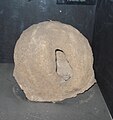|
Hornero
The hornero birds are members of the genus Furnarius in the family Furnariidae, native to South America. The English common name appears in many books as "ovenbird".[1][2] Horneros are brown birds with rather short tails and fairly long bills. They are known for building mud nests that resemble old wood-fired ovens (the Spanish word "hornero" comes from horno, meaning "oven"). These nests have a unique chambered construction.[3] While many Furnariids have different nests, the hornero nest is the reason for the common name applied to the entire family; ovenbirds (they are unrelated to the parulid warbler called the ovenbird in the United States). The size and exact shape of the hornero nest varies depending on the species. They generally lay two to four eggs, although the breeding behavior of the bay hornero is virtually unknown. Adult horneros can frequently be seen sitting on top of their nest. Except for the uncommon and relatively shy bay hornero, horneros are typically fairly common and highly conspicuous birds. They are generally noisy. All horneros are partially terrestrial, and commonly seen walking on the ground with a relatively upright posture. The rufous hornero is a national emblem of Argentina and Uruguay, two of the several countries it inhabits. TaxonomyThe genus Furnarius was introduced in 1816 by the French ornithologist Louis Pierre Vieillot to accommodate a single species, the rufous hornero, which therefore becomes the type species.[4][5] The genus name is from Latin furnarius meaning "baker" (from furnus meaning "oven").[6] The genus contains eight species:[7]
Image gallery
ReferencesWikimedia Commons has media related to Furnarius.
|
||||||||||||||||||||||||||||||||



